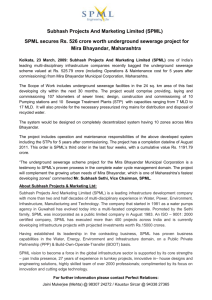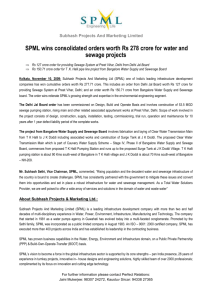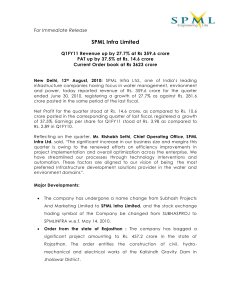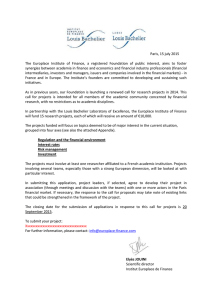Schroder Pension Management Limited Summary Solvency and Financial Condition
advertisement
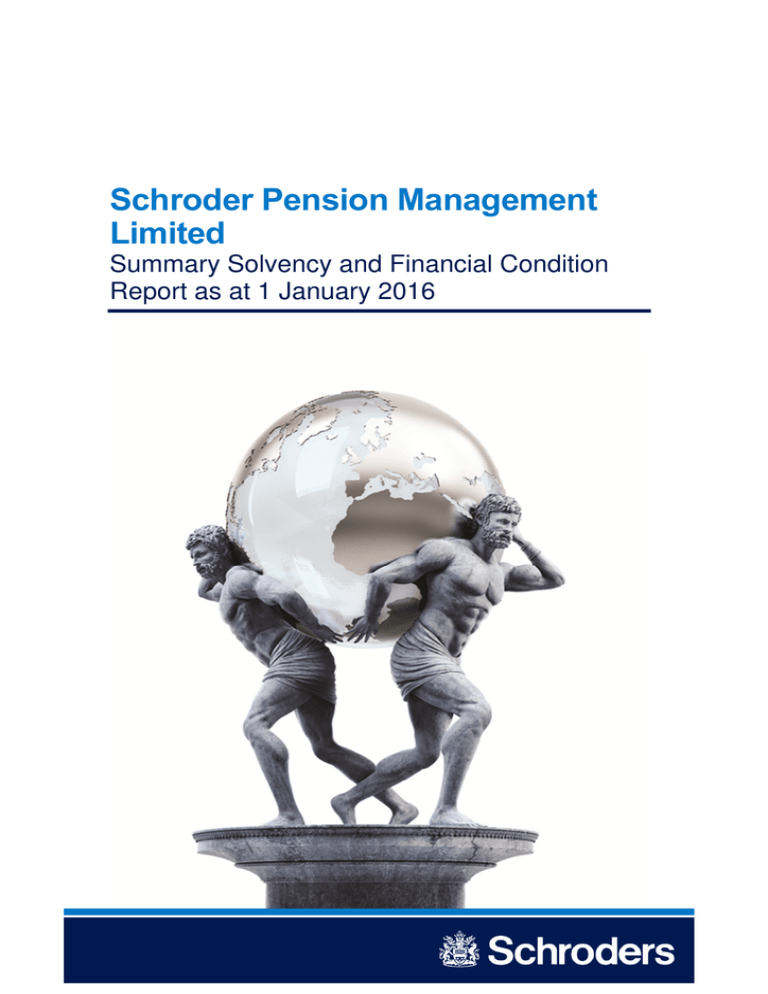
Schroder Pension Management Limited Summary Solvency and Financial Condition Report as at 1 January 2016 Contents Page Background and executive summary ....................................................................................................................................................... 1 A. Business.......................................................................................................................................................................................... 2 B. B.1. B.2. Capital management..................................................................................................................................................................... 5 Own funds ............................................................................................................................................................ 5 Solvency Capital Requirement and Minimum Capital Requirement...................................................................... 5 Schroders Summary Solvency and Financial Condition Report Background and executive summary This Summary Solvency and Financial Condition Report (Summary SFCR or the Report) has been prepared to enable the clients of Schroder Pension Management Limited (SPML or the Company), and other stakeholders, to assess the financial position of the Company following the implementation of Solvency II on 1 January 2016. The Report includes: (a) a description of SPML’s business, including its operating model and risk profile; and (b) a description of the capital management policies of the Company and the solvency position of the Company, comprising an analysis of: – the Company’s own funds based on unaudited management information as at 1 January 2016; and – the minimum capital requirement (MCR) and solvency capital requirement (SCR) of the Company as at 1 January 2016. The Report reflects the capital requirements of the Prudential Regulation Authority (PRA) Rulebook, ‘Solvency II Firms: Reporting Instrument 2015 (PRA 2015/23)’ (the Rulebook), which incorporates into the Rulebook the requirements set out in Article 51 (1) of Directive 2009/138/EC (the Solvency II Directive) and all directly applicable EU Regulations adopted in accordance with the Solvency II Directive (the Solvency II Regulations). The Report has been produced voluntarily and does not contain all the information required to be disclosed within the Company’s Solvency and Financial Condition Report, which is not required to be first published until 20 May 2017. SPML is an indirect subsidiary of Schroders plc and provides unit linked insurance contracts to the trustees of UK registered pension schemes and accepts reinsurance from other life insurance companies wishing to expand the range of funds available to their unit linked pension policyholders. Some UK occupational pension schemes are established under statute rather than by trust and consequently do not have trustees. For the purposes of this document the term ‘trustees’ is used to include the managers of such schemes. The Company has no exposure to insurance risk under the terms of these contracts. The Board of SPML reviews the Company’s capital position on a regular basis and determines the appropriate capital to be maintained by the Company. Under normal circumstances, it is the Board’s intention that the Company will maintain own funds of no less than the higher of 200 per cent. of the Company’s Pillar 1 Solvency Capital Requirement and the capital requirement calculated under the Own Risk and Solvency Assessment (ORSA). 1 Schroders Summary Solvency and Financial Condition Report A. Business SPML is a limited company incorporated and domiciled in England and Wales. The registered address of the Company is 31 Gresham Street, London, EC2V 7QA. SPML’s immediate parent company is Schroder Administration Limited and the ultimate controlling entity is Schroders plc. Schroder Administration Limited and Schroders plc are both incorporated and domiciled in England and Wales. Simplified Group Structure Supervision and External Audit SPML is authorised by the PRA and regulated by the Financial Conduct Authority (FCA) and the PRA. The Company is supervised by the Retail Life department of the PRA located at 20 Moorgate, London EC2R 6DA. SPML is audited by PricewaterhouseCoopers LLP, chartered accountants and statutory auditors, 7 More London Riverside, London SE1 2RT. This report is unaudited. Lines of business SPML writes: – Unit linked insurance; and – Unit linked reinsurance. Unit linked insurance contracts are issued solely to policyholders who are trustees of UK registered pension schemes. Unit linked reinsurance is accepted from other life insurance companies wishing to expand the range of funds available to their unit linked UK pension scheme trustee policyholders. All business is carried out in the United Kingdom. Contracts issued by SPML contain no financial options or investment guarantees. Operating model SPML outsources all operational activity to Schroder Investment Management Limited (SIM). SIM, like SPML, is a wholly owned subsidiary of Schroder Administration Limited. The outsourcing of SPML’s operational activities to SIM is contracted through a services agreement in respect of the following: • • • • • 2 general management services; marketing services; distribution services: policy administration services; and accounting services. Schroders Summary Solvency and Financial Condition Report In addition to the services agreement, SPML has entered into an investment management agreement (IMA) under which SPML delegates to SIM the investment management of the funds on the terms set out in the IMA. SPML’s Chief Executive Officer (CEO) monitors SPML’s daily interaction with SIM and the Board as a whole are responsible for the monitoring of the services agreement and IMA. Certain activities are sub-contracted by SIM to third party companies although SIM retains the operational responsibility for the delivery of these services to SPML. Sub-contracted activities include the outsourcing of fund accounting services to JPMorgan Chase Bank N.A. and the provision of transfer agency services to International Financial Data Services Limited (IFDS). SIM receives fees from SPML in exchange for the services provided, which are determined through the Group’s transfer pricing policy and vary based on the levels of Assets Under Management (AUM). Willis Towers Watson provides consulting services relating to the role of Chief Actuary. The Company’s CEO is also responsible for the monitoring of SPML’s relationship with the Chief Actuary. SPML has no direct employees. Staff involved in the management and operating activities of SPML are employed by SIM. As SPML has delegated operational activities to SIM the majority of these costs are met by SIM, under the terms of outsourcing agreements. Costs specifically associated with managing the business of SPML are recharged to SPML from SIM or are borne directly by SPML. The direct costs of SPML principally comprise third party services such as audit fees as well as the costs associated with the Chief Actuary and non-executive director. Governance i. SPML Board of Directors The Board of Directors of SPML (the Board) is responsible for ensuring sound governance, that the operational effectiveness of the risk management and control environment is maintained and that effective risk management policies are adhered to within the Schroders Group Risk Management Framework. The Board primarily consists of employees of SIM as well as a non-executive director. It is supported by the SPML Management Committee and the SPML Risk Committee, which both report to the Company’s Chief Executive Officer (CEO). The following directors were members of the Board as at 1 January 2016: Director Approved Function Graham K Aslet CF2 Non-executive director function David J Heathcock CF1 Director function, Chief Executive Officer Wayne Mepham CF1 Director function, Finance Director John A Troiano CF1 Director function, Chairman Philip C Wallace CF1 Director function ii. SPML Management Committee The purpose of the SPML Management Committee (SMC) is to assist the Board in discharging its responsibilities outlined above. The members of the SMC do not derive any management authority through membership but act in an advisory capacity to the Board. The SMC is responsible for reviewing and recommending improvements in the operation of the Company, including in relation to relevant regulation, and escalating matters to the CEO that warrant such attention. iii. SPML Risk Committee The SPML Risk Committee (SRC) reviews and monitors the adequacy and effectiveness of the process for the identification, assessment, mitigation, monitoring and management of all risks faced by SPML in achieving its business objectives. Specifically the SRC aims to maintain SPML’s effective risk management in line with the Schroders plc Group (the Group) approach and to identify risk trends and highlight key issues. The members of the SRC do not derive any management authority through membership. 3 Schroders Summary Solvency and Financial Condition Report Risk profile The Company’s principal sources of risk are operational risk, market risk and credit risk. SPML accepts no insurance risk. i. Operational risk Operational risk is the risk of loss resulting from inadequate or failed internal processes, people and systems or from external events. The management of operational risk is a core component of the Group’s risk management framework, which is based on a three lines of defence model. The first line of defence against operational risk is the business function. Line managers are responsible for identifying potential risks and implementing and maintaining appropriate controls with consideration of any relevant outsourcing arrangements. The second line of defence is provided by oversight functions including Group Risk, Compliance and Legal. Group Internal audit provides retrospective independent assurance over the design and operation of controls and is the third line of defence. SPML is not liable for any losses arising as a result of operational risk events occurring under the terms of its outsourcing agreement with SIM. This arrangement significantly reduces SPML’s operational risk exposure. ii. Market risk Market risk is the risk that the value of an investment will decrease due to changes in market factors. The Company has exposure to market risk on its linked and non-linked assets. Changes in the value of linked assets are matched by changes in the value of unit linked liabilities. Therefore the Company’s financial position is not directly impacted by a reduction in the value of unit linked assets. There would be an insignificant second order impact from a reduction in the expected level of retained fee income as a result of changes in the value of unit linked assets. If the level of unit linked liabilities decreased to a level such that retained fee income did not cover direct expenses, losses in SPML could cause the financial position to gradually deteriorate. The Company monitors the scenarios in which current direct expenses would not be covered by retained fee income. Given current levels of AUM, the likelihood of such a scenario is considered remote. The Company’s fixed expenses are low as it has no employees and outsources the majority of activities to SIM, the expenses for which vary based on levels of AUM, as described under the operating model above. Non-linked assets are generally invested in low risk highly liquid investments with short durations and little exposure to market risk. The Company’s exposure to counterparty default risk in relation to non-linked assets is considered under credit risk below. The Company’s operations are all undertaken in the United Kingdom and revenues and expenses are all transacted in sterling. Non-linked assets are also all denominated in sterling and the Company is not therefore exposed to foreign exchange risk. iii. Credit risk Credit risk is the risk that a counterparty will be unable to pay in full amounts when due and will cause the Company financial loss by failing to discharge its obligations. The Company has no exposure to credit risk in relation to cash and cash equivalents backing unit linked liabilities as the risk is borne by policyholders. The Company is exposed to credit risk on non-linked cash and cash equivalents. Cash and cash equivalents include dealing accounts used to facilitate the settlement of transactions with the various SPML life funds. Exposures within these dealing accounts are typically of short duration but may fluctuate dependent on the timing of premium receipts and other cash movements. Cash and cash equivalents are held with institutions that are at least BBB rated. SPML also has an investment in a UCITS fund, the Schroders Special Situations – Sterling Liquidity Plus Fund, which is bound by the UCITS investment concentration rules. The Company is also exposed to credit risk on other financial assets including unpaid fee debtors and a loan to its ultimate parent, Schroders plc. The Company’s exposures are monitored regularly by the Company’s Risk Committee and by the SPML Board. The Company has no historic experience of default in relation to its financial assets. Significant business and events The Company implemented the Solvency II regime on 1 January 2016. On 8 December 2015, as part of the preparations for the implementation of the Solvency II regime, the Company received a £12.5 million capital injection from its immediate parent, Schroder Administration Limited. No other significant events (business or other events) occurred in the 12 months to 1 January 2016 that had a material impact on the Company. 4 Schroders Summary Solvency and Financial Condition Report B. Capital management B.1. Own funds The Company’s own funds as at 1 January 2016 were £27.7 million. These own funds comprised £17.5 million of permanent share capital and £10.2 million of retained profit and loss and other reserves. All of the Company’s own funds are Tier 1 basic own funds and all are available to meet the SCR and the MCR without restriction. No basic own fund item is subject to the transitional arrangements referred to in Articles 308b(9) and 308b(10) of the Solvency II Directive. There are no ancillary own fund items and no deductions are required to be made from own funds. Non-linked assets that make up the Company’s own funds are predominately invested to preserve capital values and to generate a reasonable return. It is the Company’s intention to maintain own funds of no less than the higher of 200 per cent. of the Company’s Pillar 1 SCR and the capital requirement calculated under the ORSA. In assessing the own funds required, the Board considers its capital forecasts over a five year business planning period. In March 2016, the Company received approval for a further £9.0 million capital injection to provide additional capital strength as a result of Solvency II. B.2. Solvency Capital Requirement and Minimum Capital Requirement The unaudited Solvency II balance sheet position of the firm along with the SCR and MCR as at 1 January 2016 is shown below: Amounts in £m Total assets Total technical provisions Non-insurance liabilities Own funds 1 January 2016 9,750.5 (9,678.2) (44.6) 27.7 SCR 10.7 Capital surplus 17.0 SCR coverage ratio MCR 259% 4.8 The Company’s SCR has been determined using the standard formula. The Company has received approval from the PRA and has adopted a simplified approach to calculating the market risk component of the SCR. The approach represents a proportionate and prudent method appropriate to the Company’s risk profile. The simplified approach adopted assumes that all unit linked assets are invested in “Type 2” equities as defined in Article 168 of the Commission Delegated Regulation (EU) 2015/35 (the Delegated Regulation). Unit linked assets are actually invested in a mix of Type 1 and Type 2 equities and fixed interest assets. The stress test applied to Type 2 equities is onerous and so the simplified approach is prudent. Without this simplification the SCR would be lower. The SCR for operational risk is determined as 25% of the non-acquisition expenses incurred over the 12 months to the reporting date. Given the Company’s business model and the outsourcing agreement with SIM, expenses are correlated to fee income and therefore dependent on the level of AUM. SPML actively monitors the value of assets under management and the impact of changes on its capital requirements in order to ensure that it is able to continue to meet its solvency requirements. No undertaking specific parameters have been used to calculate the SCR pursuant to Article 104(7) of the Solvency II Directive. The SCR remains subject to formal supervisory assessment and includes no adjustments or capital add-on. The basis of the MCR calculation is set out in the Delegated Regulation. The result of the MCR calculations is such that the MCR for SPML is currently determined as 45% of the SCR. 5
